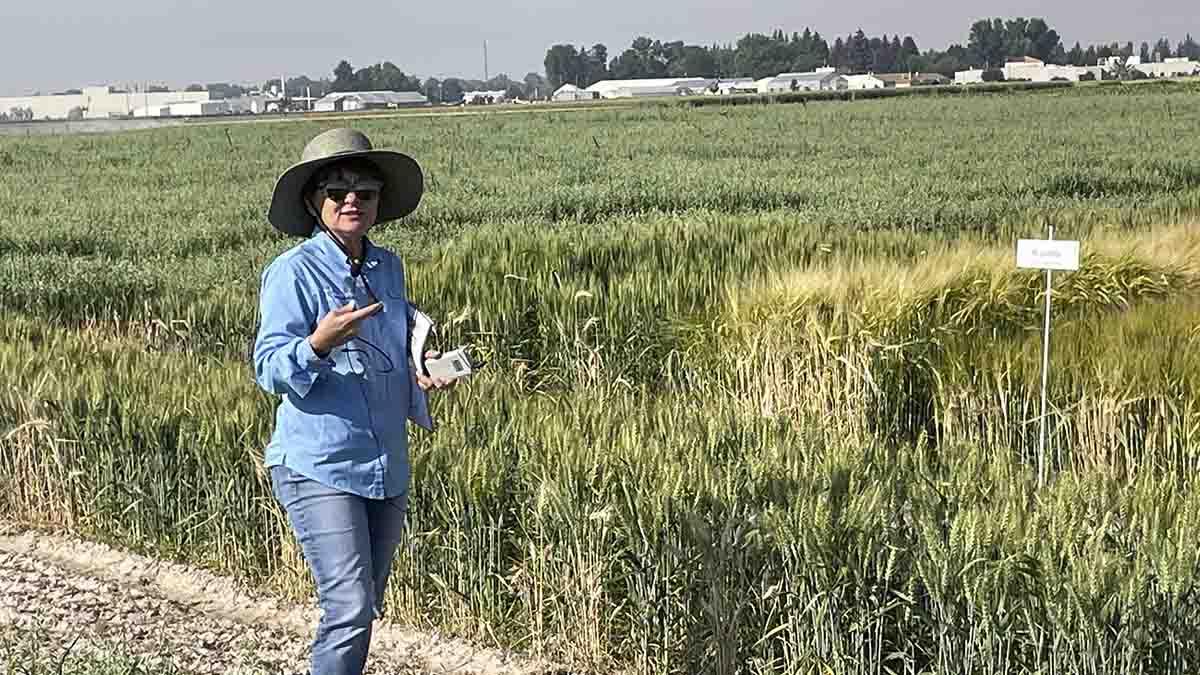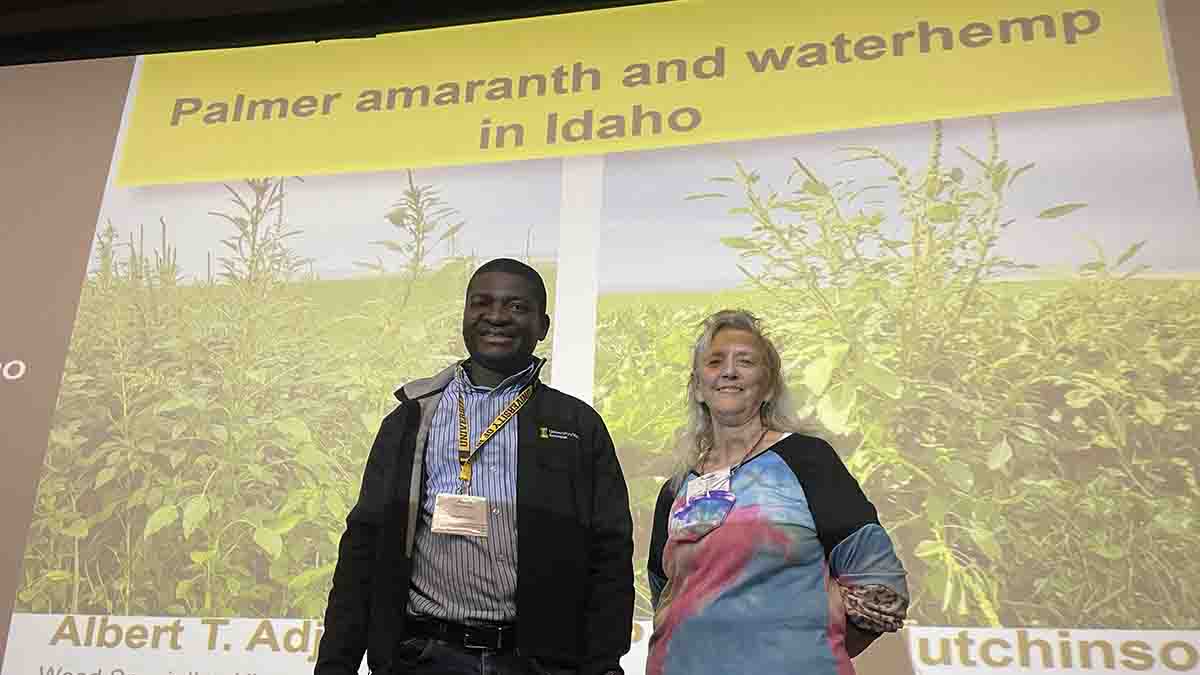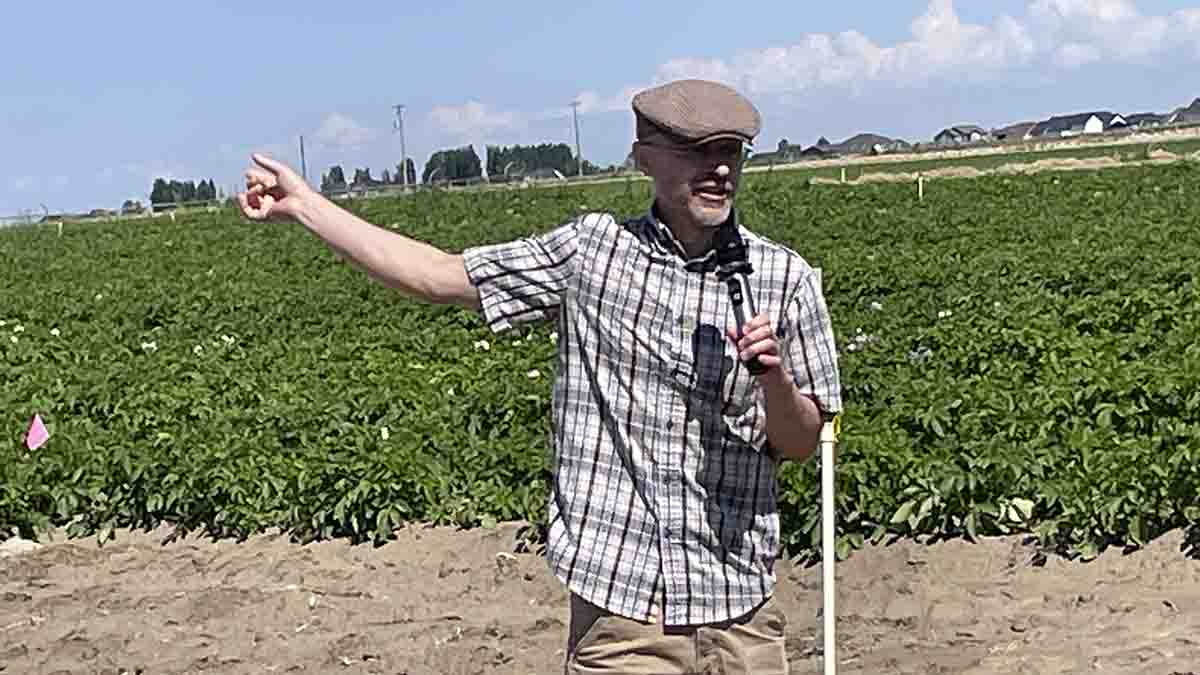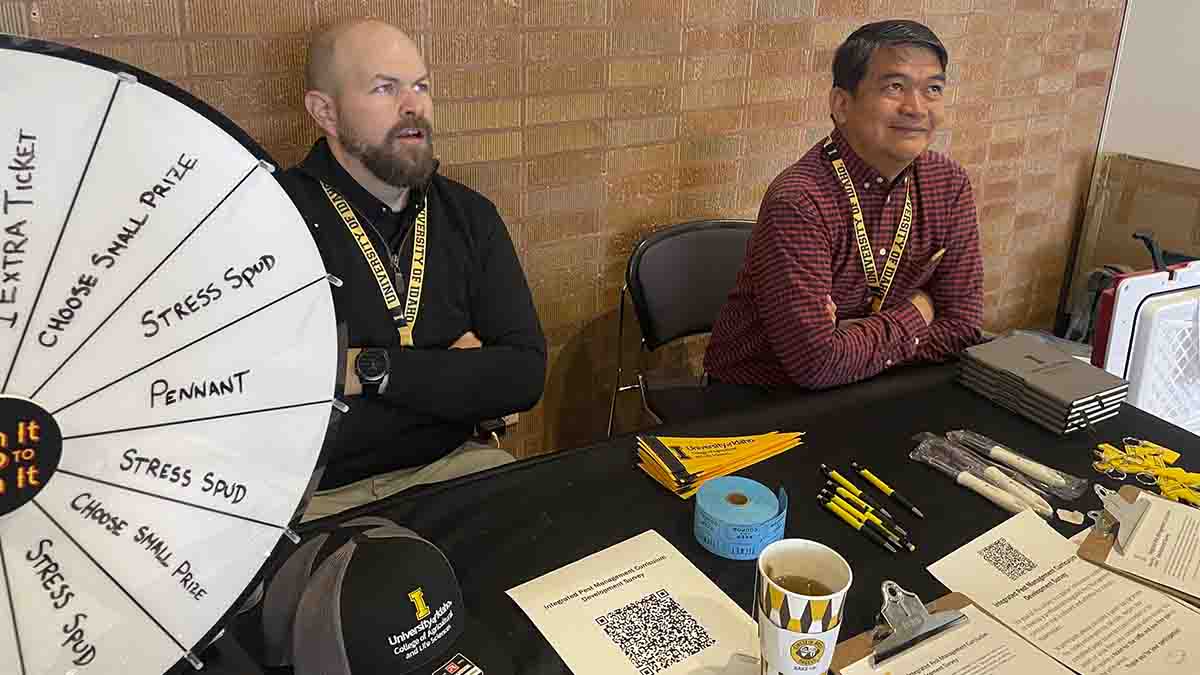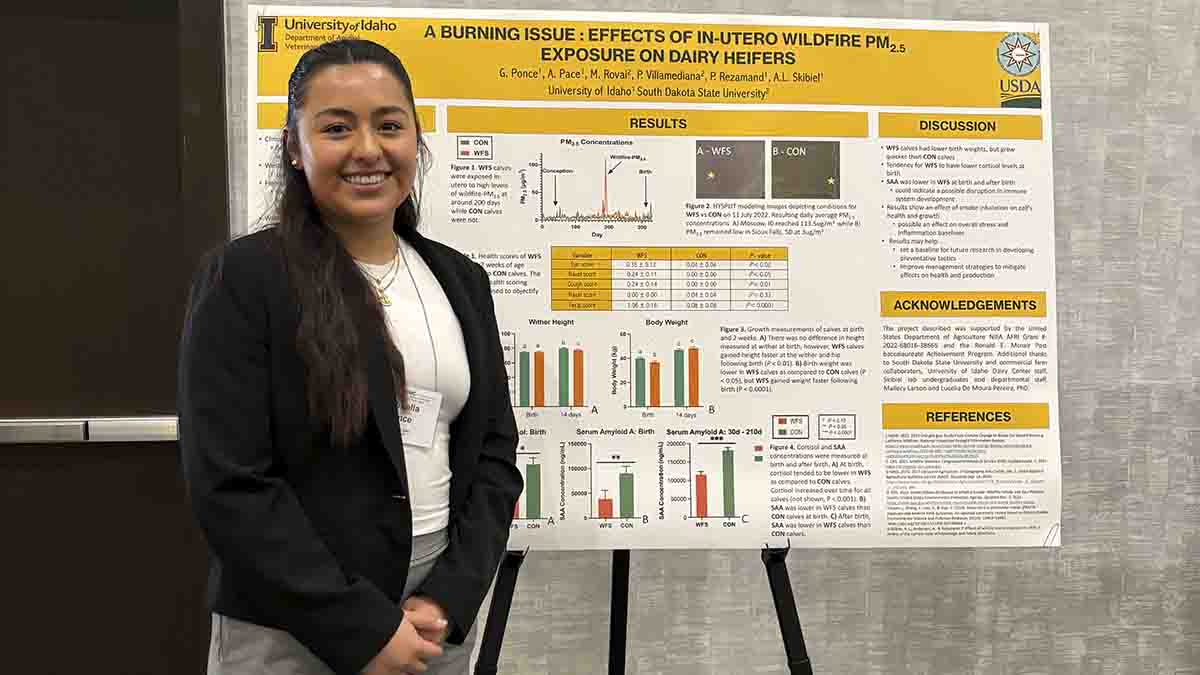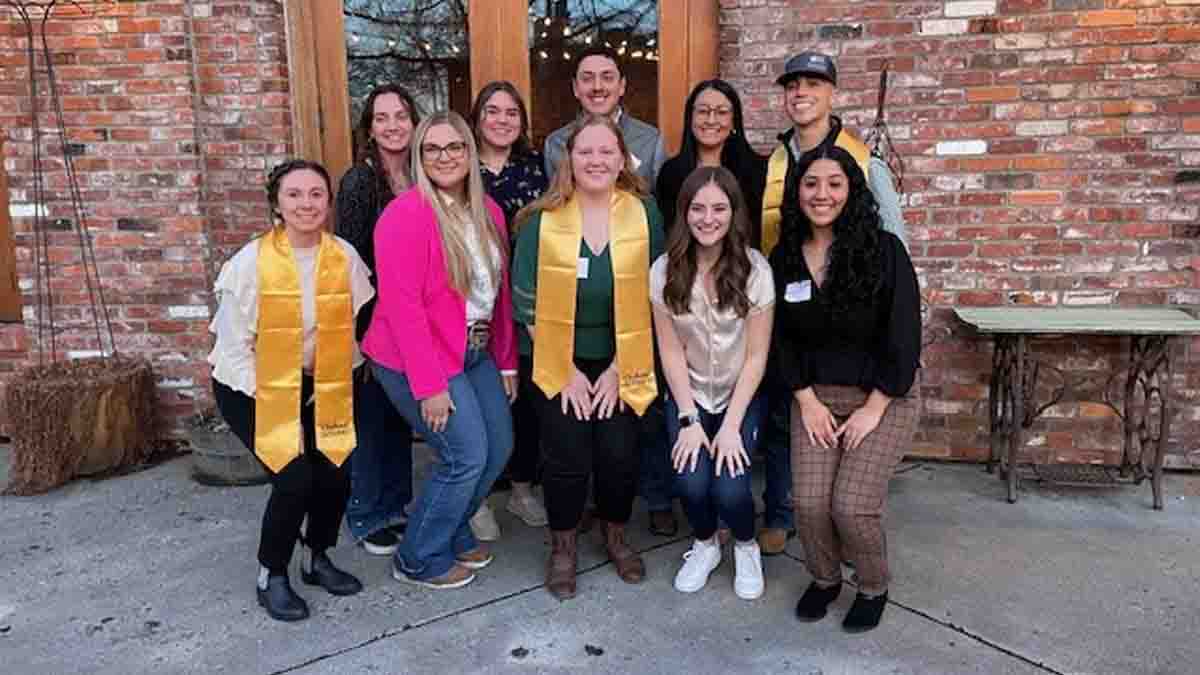Catching Up with CALS — Feb. 7, 2024
Dean's Message — Leading the Way to R1
University of Idaho is poised to make a huge step forward in its evolution as a top-flight research institution, thanks in large part to the outstanding work of CALS faculty and staff. The prestigious Carnegie Classification of Institutions of Higher Education has revised the metrics it uses for its institutional research designations for 2025, and U of I is well-positioned to achieve the highest ranking, R1. R1 is reserved for institutions with “very high research spending and doctorate production.” Under the updated methodology, R1 institutions must average at least $50 million in total research spending and graduate 70 research doctorates over a three-year period. While the average time to complete a doctorate in CALS is almost 5.8 years, we currently have 67 doctorate students listed as primary majors in CALS alone. Furthermore, total grant awards for CALS in 2023 totaled $91.56 million — poles apart from the roughly $15 million in yearly extramural funding our college brought in when I first became dean just eight years ago. This accomplishment is the fruition of a goal that President Scott Green set shortly after assuming his position in 2019. It’s also a sign that we’re positioning ourselves well for the future through the decisions we’re making, the programs we’re growing and the facilities we’re opening, both within the college and throughout the broader university.
The benefits of R1 status will be far reaching, touching everyone affiliated with U of I. Our reputation will be dramatically enhanced, making us more attractive to elite students and faculty. The name of our institution will carry greater weight when we apply for competitive grants. As our research enterprise grows, so will our wherewithal to invest in support personnel, including technicians, graduate students, postdoctoral researchers and staff involved in critical work such as grant development, record keeping and compliance with policies and regulations. New doors will open to U of I faculty seeking to conduct world-class research. “People want to be part of something that is successful and has a very strong reputation,” said Shirley Luckhart, a professor of entomology, plant pathology and nematology and biological sciences and co-director of the Institute for Health in the Human Ecosystem. “I think there are substantial benefits in terms of just being able to say to people, ‘Hey, we’re players in this very large research-generating institutional landscape of R1s.’” Our faculty will receive more frequent invitations to accept national-level appointments, join prestigious oversight panels and serve on review committees of major funding entities. Large research institutions will be more receptive to collaborating with our investigators on far-reaching projects, breeding more innovation and ideas for future research. Reaching this goal has involved careful planning, hard work and forward-thinking investment, all of which will have to continue for us to build upon our momentum and remain a fixture in the R1 category. Luckhart and I represented CALS on a 20-member campus working group with the goal of moving the university toward R1 status.
In our final report (pdf), our working group detailed a plan to improve the university’s research culture, emphasizing support for post-doctoral scholars, support for graduate students and better utilization of funds awarded by federal grantees to cover costs of facilities and administration. Under the direction provided by President Scott Green and Vice President Chris Nomura who supported the working group’s vision, U of I launched the P3-R1 Grant Matching Program in early 2021, investing $3 million in institutional funds coming from a public-private partnership on the university’s energy infrastructure toward new doctoral research assistantships and postdoctoral fellowships. Competition for extramural funding is intense, and having local matching funds through P3 improves our odds. Luckhart — a relentless grant-writer who has been funded continuously by the National Institutes of Health since 1997 and who currently administers three RO1 grants from NIH — can attest that researchers must often submit many failed grants for every one that gets accepted. Yet I’m encouraged that CALS researchers continue taking big swings in the pursuit of funding, and occasionally we knock one out of the park. For example, our college is in the process of rolling out the largest grant in U of I’s history — a $55 million USDA award called the Innovative Agriculture and Marketing Partnership, formerly Climate Smart Commodities for Idaho.
I’m confident that we will remain on track to achieve an R1 designation in 2025 and I can guarantee we won’t rest on our laurels when we get there — with CALS leading the campus toward excellence. We’ve made several major capital investments recently to grow our research infrastructure. CALS is also investing in programs that are unique in the nation. For example, CALS’ partnership with the College of Natural Resources at Rinker Rock Creek Ranch in the state’s Wood River Valley brings together diverse stakeholders to collaborate on ecological grazing research at a watershed scale. We’re building what will be the nation’s largest research dairy, called the Idaho Center for Agriculture, Food and the Environment (Idaho CAFE), in the Magic Valley. At a demonstration farm associated with Idaho CAFE, researchers will study the connection between plant and animal agriculture. Our forthcoming Deep Soil Ecotron will include 3-meter soil columns and an array of sensors and monitoring devices, enabling researchers to analyze soils at greater depths than anywhere else in the world. These facilities will support new faculty, staff and students while giving our researchers a competitive edge in securing grants and establishing ties with the giants in research. R1 is just the beginning.

Michael P. Parrella
Dean
College of Agricultural and Life Sciences
By the Numbers
CALS has more than 14,000 acres of land for research and teaching and 9 research and Extension centers across the state. CALS faculty conduct 35% of the sponsored research at U of I and are responsible for $91.6 million in annual sponsored research. CALS has more than 200 individuals with a research appointment and brings in more than $489,000 in annual wheat variety royalties from Limagrain Cereal Seeds.
Our Stories
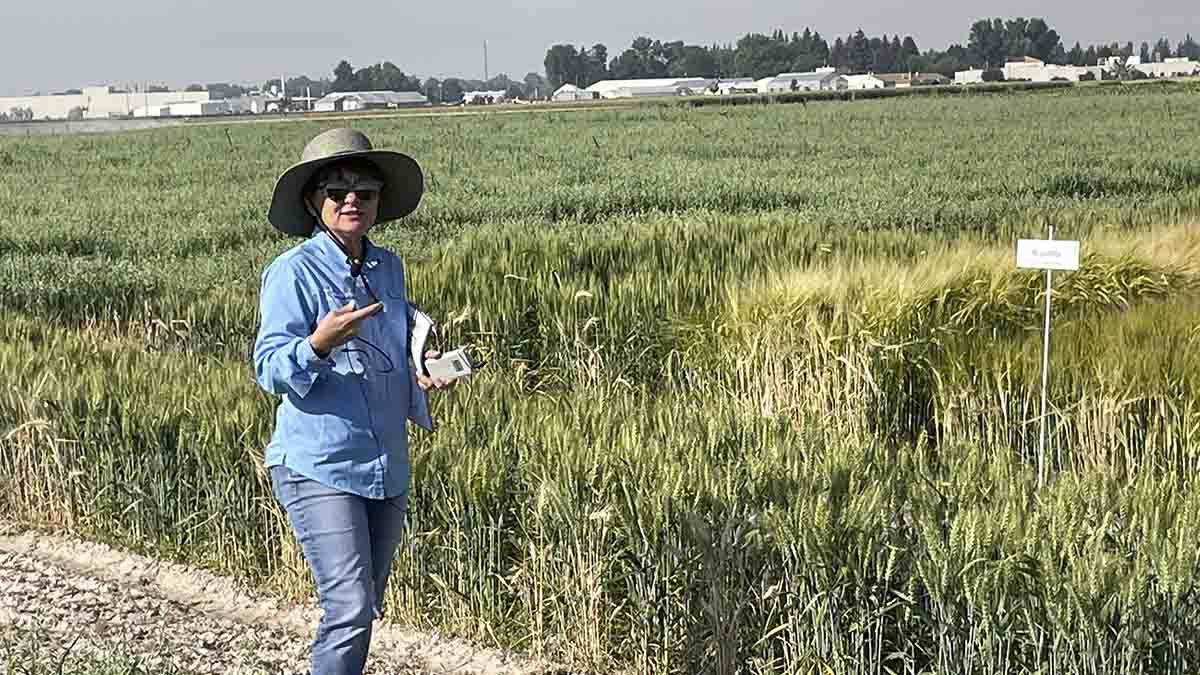
Researcher Creates Variety Trial Database
University of Idaho is aggregating decades of crop variety trial data from Idaho, Oregon and Washington, creating a database to help researchers and growers identify trends and pinpoint varieties that perform best over time at various locations.
A team led by Julia Piaskowski, director of statistical programs with U of I’s College of Agricultural and Life Sciences, has compiled 2,166 wheat variety trial records from 69 locations, dating back 22 years.
The unique database, called the Western Agricultural Variety Explorer (WAVE), will soon be expanded to also include several years of barley, cool-season legume and canola variety trials. Data from the additional crops has already been collected and curated, but web tools must be built to sort and filter the records before they can go live on the database.
WAVE is geared toward meeting the needs of crop researchers, but the team has also released a grower-focused free phone app. Other collaborators on the project include Juliet Marshall, Kurtis Schroeder and Jim Davis of U of I; Olga Walsh, formerly of U of I; Ryan Graebner of Oregon State University; Clark Neely and Stephen Jones of Washington State University; and Steve Van Vleet, formerly of Washington State University.
Research programs such as U of I, OSU and WSU invest considerable resources in conducting variety trials, and WAVE aims to make certain the results are accessible and pooled together to tell a more complete story. WAVE users can sort information down to the individual plot level.
“They run high-quality field trials producing high-quality data, and they’re expensive,” Piaskowski said. “I’ve referred to it as a data goldmine in the past and I still feel that way about it.”
The WAVE team has curated gigabytes of data, recording 30 traits per variety, such as yield, protein, plant height and days to heading. In addition to shedding light on performance of individual varieties, the data should provide insights into broader questions, such as how climate change is affecting wheat performance. Much of the team’s time has been spent poring through variety trial records, ensuring they use consistent terminology and variety names. The database will be updated heading forward as new trial results are published.
“We’re not managing our data optimally, and when you’re not doing that you risk losing it,” Piaskowski said. “It ends up on hard drives that nobody can access, or people make mistakes in data curation that are not caught, and those perpetuate in the final products.”
The grower app omits records from experimental, numbered crop lines, which aren’t commercially available for growers to plant. Marshall, a plant pathologist who heads U of I’s Department of Plant Sciences and oversees eastern Idaho cereal trials, believes the app will help growers find varieties that consistently excel in different geographic areas and field conditions over several years. She’s also confident that WAVE will open new doors for researchers.
“One of the interesting things is potentially if you were looking at climate data and needed to make correlations with yield, heading date or lodging, there’s an ability to use a specific database and correlate that with other things a climate scientist might be interested in,” Marshall said. “Having this dataset available online will improve its accessibility so researchers across the country, and even the world, will have access to it.”
Work on WAVE began in 2020 when the Idaho Wheat Commission awarded U of I a one-year, $28,869 grant. The U.S. Department of Agriculture’s National Institute of Food and Agriculture (USDA-NIFA) awarded additional funding toward the project via a three-year, $500,000 grant, award No. 2021-67021-34255, 100% of which is federal funding. The USDA-NIFA grant is set to expire in March of 2025, following a one-year extension.
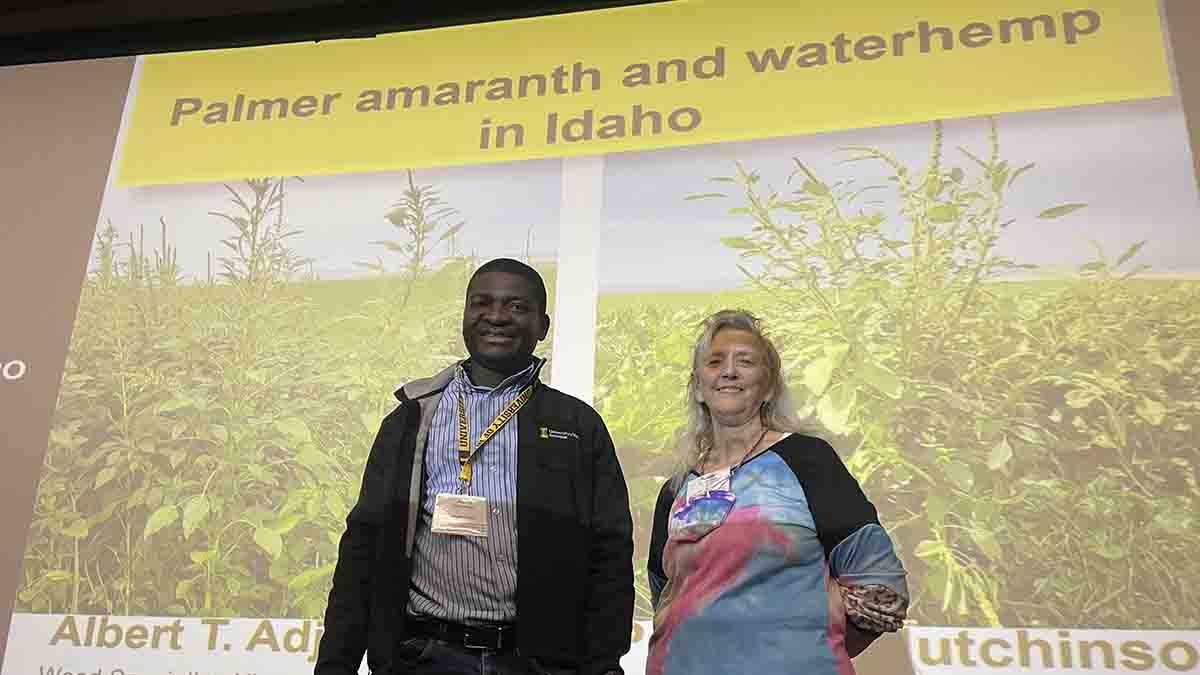
Pigweed Problems
It’s been less than two years since University of Idaho Extension weed scientist Albert Adjesiwor’s fears were realized and a pair of problematic pigweeds — Palmer amaranth and waterhemp — were first found in Idaho.
Yet it’s already clear to Adjesiwor that the weeds have established a firm foothold throughout the Magic and Treasure valleys. He acknowledges the window to eradicate the two invaders has closed, and his focus must shift toward educating farmers about how to manage them. And managing Palmer amaranth and waterhemp is no easy task.
The weeds tower over crop canopies — Palmer amaranth can grow more than 10 feet tall — and both species have developed broad resistance to common herbicides, making them extremely tough for growers to kill. Their seeds can survive in soil for up to five years, making it critical for farmers to make certain weeds that escape herbicide application are killed using any means possible before going to seed.
In potatoes, a density of one Palmer amaranth plant per three feet of crop row can cause yield losses of about 50%. Adjesiwor saw one heavily infested potato field patch in Bruneau that he suspects was a total loss.
If the weeds are too rampant in a field to be hand pulled, Adjesiwor advises mowing them, before applying mixtures of herbicides. Adjesiwor has seen evidence that the weed seeds entered Idaho in birdfeed, in cottonseed meal fed to cattle and on farm equipment brought in from surrounding states.
“These weeds are tough to control, and they develop resistance to most herbicides we use,” Adjesiwor said. “My fear is they might have come in from states where they have already developed resistance to the herbicides we use in Idaho. Even if they are not resistant to most of the herbicides we use, it will not take long for them to develop resistance in the state because we apply the same herbicides every year.”
Sounding the alarm
From Burley in the Magic Valley to Parma in the Treasure Valley, Palmer amaranth has become widespread, even growing in roadway medians.
Adjesiwor couldn’t find Palmer amaranth or waterhemp when he drove throughout the region scanning farm fields shortly after he started working at the U of I Kimberly Research and Extension Center in 2020. He had a suspicion, however, that it would only be a matter of time before one or both of the weeds would be discovered in Idaho, knowing they were present in surrounding states.
Hoping to keep the problem at bay for as long as possible, he published an Extension bulletin in 2021 offering background and physical descriptions of the plants. Palmer amaranth has egg-shaped leaves and especially long leaf petioles. Waterhemp has slender foliage. Both weeds have separate male and female plants.
In 2022, Adjesiwor brought potted samples of the weeds to field days, seeking to raise awareness among growers and agronomists. After one of the field days, he got a call from a Glenns Ferry farm about a pigweed that couldn’t be killed by glyphosate, which is the active ingredient in Roundup herbicide. The weeds proved to be Idaho’s first known waterhemp. He received another call a short while later about pigweeds in Homedale, which Adjesiwor confirmed as the state’s first known Palmer amaranth.
“Probably they were here for a while, but people needed to know what they looked like,” Adjesiwor said.
Reports of the two pigweeds began to flood in after Clarke Alder, an Amalgamated Sugar Co. weed scientist, investigated a company crop consultant’s report of a glyphosate-resistant pigweed in an Owyhee County farm field in late July 2023.
“As soon as I got there, I knew what I was looking at and I called Albert Adjesiwor immediately,” Alder recalled.
Alder, Adjesiwor and Oregon State University (OSU) weed scientist Joel Felix collaborated to develop an identification guide for the weeds and launched a regional scouting effort. Alder recruited 20 Amalgamated Sugar crop consultants to keep an eye out for the weeds and report GPS locations of anything suspicious. They’ve also encouraged agronomists from other companies to assist. As a result, they’ve now located 71 populations of the two pigweeds in southern Idaho.
Resistance challenges
Adjesiwor has been collecting seeds from mature Palmer amaranth and waterhemp plants throughout the region, planting them in a greenhouse to increase seeds and evaluate the populations for resistance to common herbicides.
None of the waterhemp seeds germinated, as they were likely harvested before they were ripe and viable. He’s been screening Palmer amaranth samples, however. He’s already confirmed they have broad resistance to glyphosate, and he anticipates he’ll also find resistance to Group 2 herbicides, which include imidazolinones, sulfonylureas, sulfonamides and triazolopyrimadines.
Glyphosate resistance is especially concerning to Adjesiwor, given that all of the sugar beets raised in Idaho have been engineered to withstand glyphosate applications. Adjesiwor emphasized that both weeds are most effectively managed with pre-emergence herbicides.
“Growers are not used to managing these weeds,” Adjesiwor said. “My fear is they will not know they have them until they come up. In potatoes there are only a few options to manage Palmer amaranth and waterhemp once the potato plants come up. When sugar beets come up, growers have no options.”
Responding to the threat
Adjesiwor, Pamela Hutchinson, a cropping systems weed scientist at the U of I Aberdeen Research and Extension Center, and collaborators from OSU and Washington State University have applied for a $27,000 grant through the Northwest Potato Research Consortium.
The funds would launch a tri-state effort to scout for the two pigweeds, gather seeds and raise plants from them to screen for resistance to common potato herbicides. They would also support a graduate student to help with spraying and evaluation. Hutchinson will aid in the search for Palmer amaranth and waterhemp in eastern Idaho, where it’s possible the weeds haven’t been found only because people haven’t looked for them.
“We’ve seen it in southcentral Idaho and we expect it will move over here,” Hutchinson said. “That’s why we’re doing this survey. We’re trying to get ahead of it.”
Adjesiwor and other stakeholders will request additional funding from chemical companies to collect, store and test weed tissue samples, which would provide growers quicker, in-season herbicide-resistance results while also enabling them to record data without allowing weeds to go to seed.
On Jan. 10, Alder and Amalgamated Sugar petitioned the Idaho State Department of Agriculture to have Palmer amaranth and waterhemp listed as noxious weeds. Palmer amaranth is native to the desert southwest, and waterhemp is native to the midwest, which is why they haven’t been listed federally as noxious weeds. They’re both designated as noxious weeds in several other states, however.
A noxious weed designation would enable the state and counties to devote resources toward aiding growers in the weed battle, including spraying the weeds on roadsides.
“Glyphosate has been a massive tool for us since 2008. The problem is these weeds are already resistant to glyphosate, and they need to be controlled at a young stage of their lifecycle,” Alder said. “We have to be very proactive with these weeds in particular because of the limitations of control measures and because of their lifecycle, otherwise the repercussions can be quite detrimental to sugar beet crops — 70%-plus yield losses in the worst-case scenarios.”
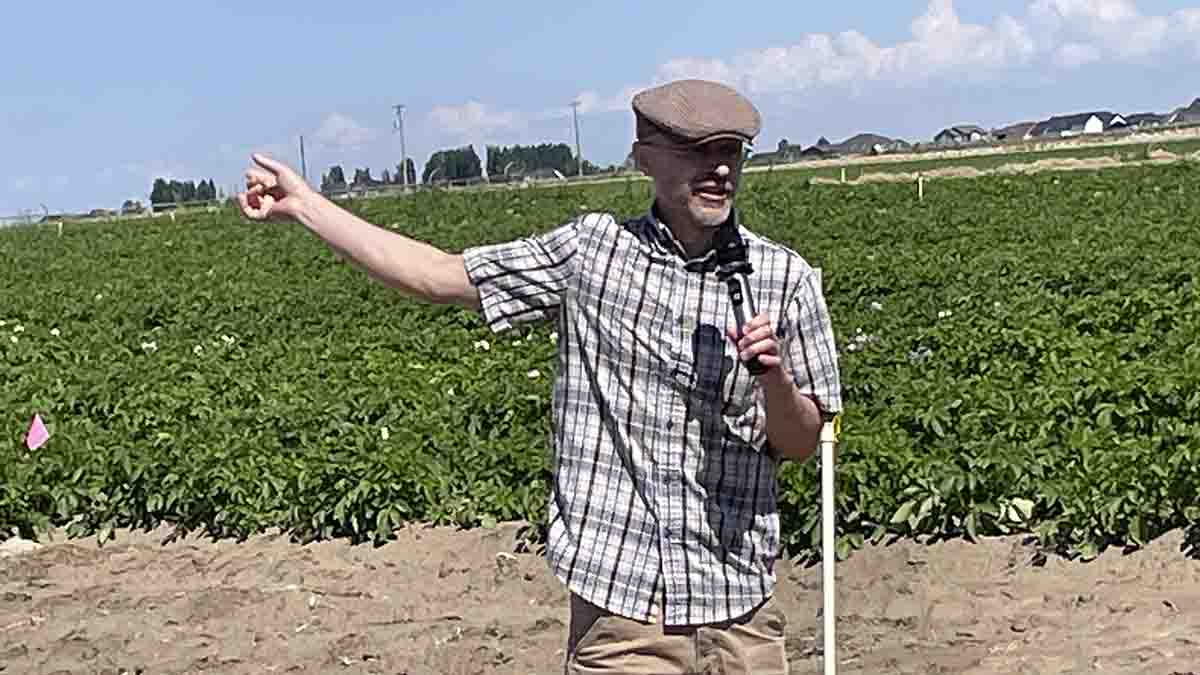
Scouting for Potato Psyllids
For a second consecutive year, a University of Idaho pest monitoring program trapped relatively few potato psyllids in Idaho spud fields during 2023, but slightly more psyllids than normal harbored the bacterium that causes the crop disease zebra chip disease.
“Zebra chip was observed to some extent in the field, but I have not heard of any major disasters,” said U of I entomologist Erik Wenninger, who oversees the potato psyllid monitoring program.
Potato psyllids are tiny, winged insects that can transmit the Liberibacter bacterium, which causes zebra chip in spuds. In addition to affecting plant health and reducing yields, the disease creates bands through tuber flesh that darken when fried, rendering the infected potatoes unmarketable for aesthetic reasons.
U of I posts average psyllid counts and positive tests for Liberibacter by region throughout the growing season at idahopestmonitoring.org, which is a new central hub for university pest monitoring programs. The site also includes data from aphid monitoring in northern and southern Idaho, as well as results of a fungal spore trapping network.
During the 2023 growing season, psyllid numbers spiked from mid to late August. Counts were highest in the Treasure Valley, peaking at just over 0.6 psyllids per trap. Psyllid counts reached just under 0.1 psyllids per trap in the Magic Valley, and there were no psyllids captured in eastern Idaho.
About 6% of all psyllids captured during the season tested positive for the bacterium, compared with about 1% during most years. Though more psyllids were captured during 2023 than in the prior year, 22% of psyllids trapped in 2022 tested positive.
Zebra chip first surfaced in the Pacific Northwest in 2011. During the following growing season, UI Extension, working with an ad hoc group of industry officials and other stakeholders, launched a comprehensive annual monitoring program. The program entails placing yellow sticky traps in potato fields throughout the state and testing any captured psyllids for the presence of the bacterium to alert growers. U of I works with crop consultants and processors who collaborate with their growers to have sticky traps set on the borders of 70 to 100 fields.
Psyllids arrived in large numbers in 2012, and 28% of them tested positive for Liberibacter.
Disease pressure has been much lower since 2012, and the stakeholder group chose to scale back its monitoring program beginning in 2018. For example, the duration of psyllid trapping and testing has been shortened by several weeks, and the number of sticky traps they set out has been reduced.
The Idaho Potato Commission covers the roughly $30,000 cost of potato psyllid monitoring and testing, and potato growers receive a good return on their investment.
“I think given the potential for disasters, which we did see in other years and other growing areas have seen, the relatively small cost of the monitoring program is worth it,” Wenninger said. “A lot of growers use our monitoring program to make insecticidal decisions. The biggest benefit is if they don’t see psyllids and bacterium, they can hold off on insecticides. Without the information they may tend to spray just in case.”
Faces and Places
University of Idaho Extension is inviting people involved in the potato industry to aid in developing professional curriculum on integrated pest management (IPM) that is relevant and effective for industry stakeholders. The survey seeks to identify current knowledge, knowledge gaps and industry priorities regarding IPM. Researchers James Woodhall, Kasia Duellman and Pam Hutchinson are the leads on the survey, which was administered to attendees of the Idaho Potato Conference 2024, hosted in January in Pocatello. They’ve also invited industry stakeholders to take the survey online through March 1.
Gabriella Ponce, a senior from Wendell studying animal and veterinary science: production option, placed second in the poster competition at the 2024 Pacific Northwest Animal Nutrition Conference with her poster, A Burning Issue: Effects of In-Utero Wildfire PM2.5 Exposure on Dairy Heifers. Ponce is a research assistant with AVFS professors Amy Skibiel and Pedram Rezamand.
Shiyi Chen, an assistant professor specializing in child development within the Margaret Ritchie School of Family and Consumer Sciences, has won the Emerging Scholar Award. The award is offered annually by the Eastern Educational Research Association (EERA) and recognizes an early career researcher with outstanding theoretical and applied research who contributes to the national professional body of knowledge about education and demonstrates excellence in teaching, advising and mentoring. Prior to joining U of I, Chen was a frequent attendee of the EERA annual conference while in Florida, making her eligible for the award.
Applications are open for the next cohort of Chobani Scholars, a $20,000 scholarship for students from the Magic Valley enrolling in fall 2024 and planning to pursue an agriculture-related degree. Criteria and the application process is available at: uidaho.edu/cals/chobani.
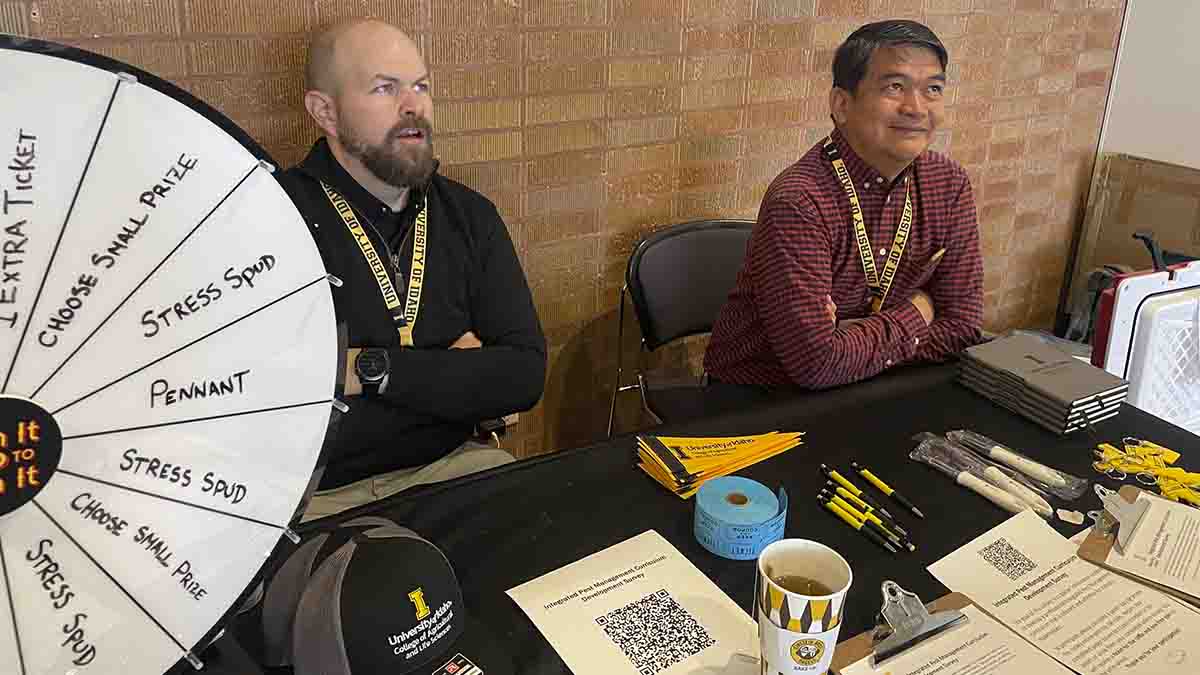
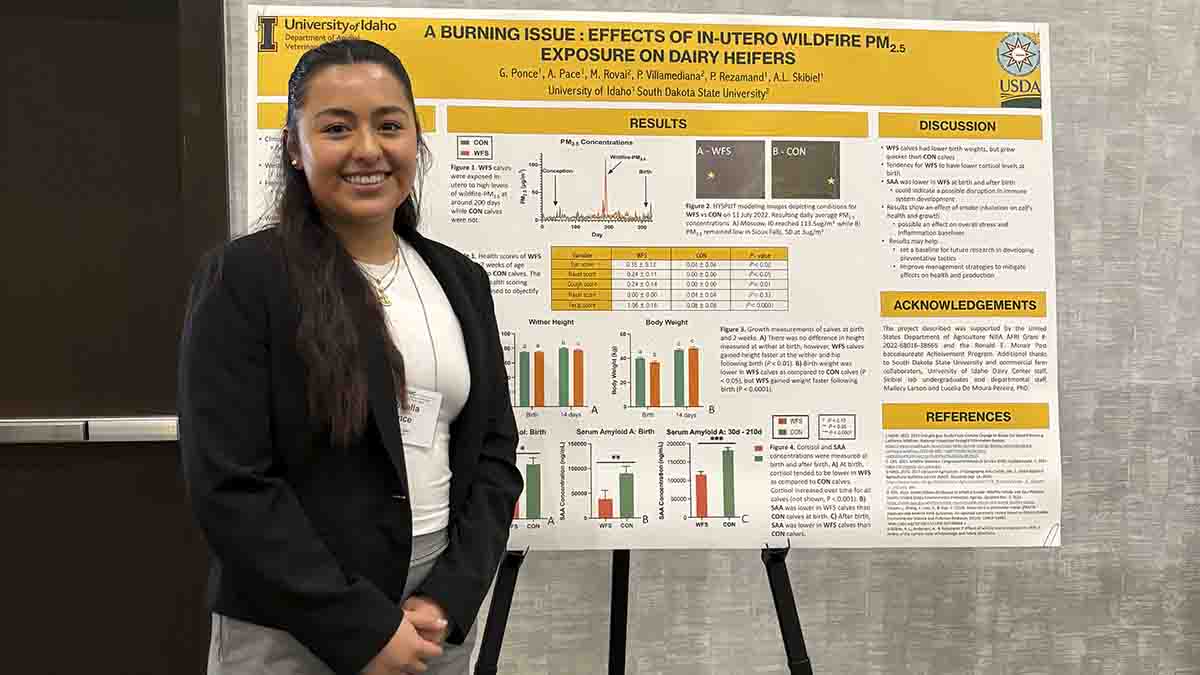

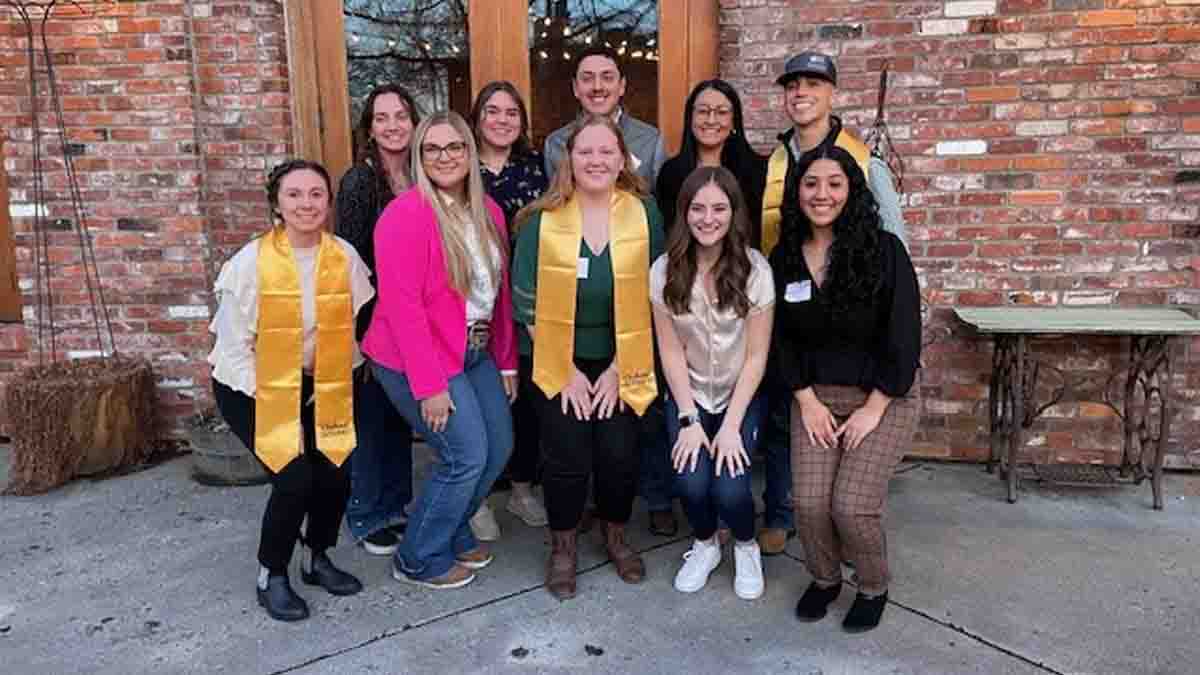
Events
- Feb. 7, 8, 9 — Cereal Schools, Pocatello, Idaho Falls, St. Anthony, Soda Springs, Preston
- Feb. 15 — Dehydration Basics, Online
- Feb. 17-19 — Know Your Government, Boise
- Feb. 20 — Grand Opening - Idaho Center for Plant and Soil Health, Parma
- Feb. 21 — Heritage Orchard Conference, Sandpoint Organic Agriculture Center, Online
- Feb. 22, March 28, April 25, May 23 — Kids in the Kitchen Cooking Club, Online
- March 4 — CALS Awards nomination form closes March 4 at 5 p.m. Save the Date: Awards banquet (April 24) registration will open in March
- March 4-5 — Pollinator Summit, Latah County Fairgrounds







